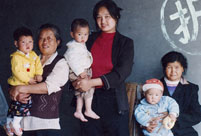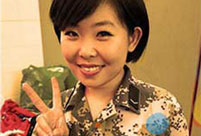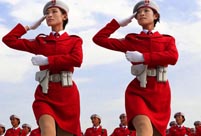 Close-up view of August Aerobatic Team
Close-up view of August Aerobatic Team
 Goddesses married in 2014
Goddesses married in 2014
 Polar region photos raise worldwide awareness of global warming
Polar region photos raise worldwide awareness of global warming
 Get off at the last stop — Beijing Subway in vision
Get off at the last stop — Beijing Subway in vision
 Top 100 beauties in the world!
Top 100 beauties in the world!
 Gallery: Who is the most beautiful one?
Gallery: Who is the most beautiful one?
 If you like autumn, put your hands in the air!
If you like autumn, put your hands in the air!
 Fan Bingbing's "Queen style" in new play
Fan Bingbing's "Queen style" in new play
 Lingerie show at 2014 Miss China
Lingerie show at 2014 Miss China
 J-10 fighters show aerobatic stunts in smog-free sky
J-10 fighters show aerobatic stunts in smog-free sky

Further easing in consumer inflation and accelerating industrial deflation in November reflect stagnation in the world's second-largest economy, and that may push the central bank to cut banks' required reserve ratios as a means of easing liquidityand stabilizing growth, market observers said on Wednesday.
They said that China's top leaders may discuss a reduction in the 2015 Consumer Price Index target to 3 percent, from 3.5 percent this year, during the Central Economic Work Conference in Beijing. A statement will be issued when the meeting endson Thursday.
The comments followed a report by the National Bureau of Statistics, which said that the CPI edged down to 1.4 percent year-on-year in November from 1.6 percent in October, the lowest level since December 2009.
Warm weather and adequate supplies pushed food prices down 0.4 percent month-on-month.
The cost of items in the CPI basket other than food slid 0.1 percent from October, the first drop in three months, as global oil prices weakened.
"Consumer prices may remain low, and the full-year CPI is expected to be 2 percent, much lower than the 3.5 percent target," said Lian Ping, chief economist at Bank of Communications Co Ltd.
"The CPI may continue to ease next year."
The NBS also said that the Producer Price Index sank 2.7 percent year-on-year in November, the largest decline since July 2013. The index has been negative for 33 consecutive months-the longest period of deflation in 30 years.
Deepening industrial deflation is difficult to curb in the short term, experts said, because the prices of raw materials, including oil and natural gas, may remain soft around the world.
Liu Ligang, chief economist in China at Australia and New Zealand Banking Group Ltd, said that the central bank is likely to cut required reserve ratios by year-end to curtail deflation risks.
"The weak PPI means Chinese enterprises are struggling amid the economic slowdown. Their profits will drop further as their debts surge," said Liu.
The People's Bank of China, the central bank, cut the benchmark interest rates in November. But the cuts were asymmetric, and deposit interest rates and interbank market rates remain high.
"That means the effect of the rate cuts is weak, and the central bank must cut the reserve ratio more than once to ensure that the monetary policy is effective," Liu said.
He forecast three RRR cuts of 50 basis points each in 2015.
Strong headwinds from the property market correction, overcapacityin upstream industries and high local government debtare the main causes of the slowdown.
"Increasing deflationary pressure in China will push up real interest rates and compel more rate cuts," said Wang Tao, chief economist in China at UBS AG.
"We expect at least two more cuts in benchmark lending rates totaling 50 basis points by end-2015, and we see the central bank continuing to provide sufficient liquidity to keep the money market rates low.
"Rate cuts are key in driving down debt service burdens, improving corporate cash flow and reducing financial risk by slowing the pace of nonperforming loan formation. We do not see these measures as having a significant stimulative impact on credit and GDP growth," she said.
(For the latest China news, Please follow People's Daily on Twitter and Facebook)
 20 years on: Relocated Three Gorges residents through lens
20 years on: Relocated Three Gorges residents through lens PLA HK Garrison veterans leave behind beautiful smiles
PLA HK Garrison veterans leave behind beautiful smiles Representative beauties of each province in China
Representative beauties of each province in China Chestnut girl goes viral online
Chestnut girl goes viral online Victoria's Secret Fashion Show
Victoria's Secret Fashion Show In photos: Bright and brave female soldier of PLA
In photos: Bright and brave female soldier of PLA China's charming first lady
China's charming first lady Excellent photos of Zhuhai Air Show
Excellent photos of Zhuhai Air Show China's heavyweight aircraft
China's heavyweight aircraft Christmas factory
Christmas factory Xi’s book enhances mutual understanding
Xi’s book enhances mutual understanding Stock markets fall back sharply
Stock markets fall back sharply Report details luxury cars in China
Report details luxury cars in ChinaDay|Week|Month